Ocypode ceratophthalmus (Pallas, 1772)Horn-eyed Ghost Crab
Table of Contents
| Front view of a Horn-eyed ghost crab (Photo: Christopher Puan) |
Introduction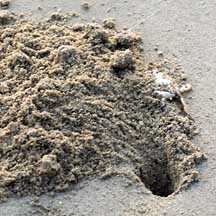
Burrow entrance of a Horn-eyed ghost crab (Ria Tan)

Ever wondered what lurks beneath the holes found on the beaches? The creature responsible for these burrows are the elusive Horn-eyed ghost crabs (Ocypode ceratophthalmus). They are commonly found along the intertidal zones of sandy beaches in the tropics. These crabs are pale in colour with a dark H-shaped groove on the top and have distinctive horns on their eyes; hence it’s name. They are extremely fast runners, so fast that they are one of the fastest crustaceans on the beach. Beaches with ghost crab populations are often full of burrows; the deepest can reach up to 1.3m. These crabs are not fussy eaters, they are mostly scavengers or hunters. Some preferred food items are carcasses, worms, fishes, clams, crabs and even their own species.
 |
| Half-buried crab |
Ghost Crab @ Changi from SgBeachBum on Vimeo.
Distribution and Habitat
Horn-eyed ghost crabs are found throughout warmer climates i.e. the tropics and are native to regions ranging from East Africa to Australia. These crabs prefer sandy beaches and are commonly found within the intertidal zone, which are covered with their burrows.[1][2] Crabs tend to select areas with access to water and sand consistency should be suitable for digging.[3]
Where the crab has
been found:
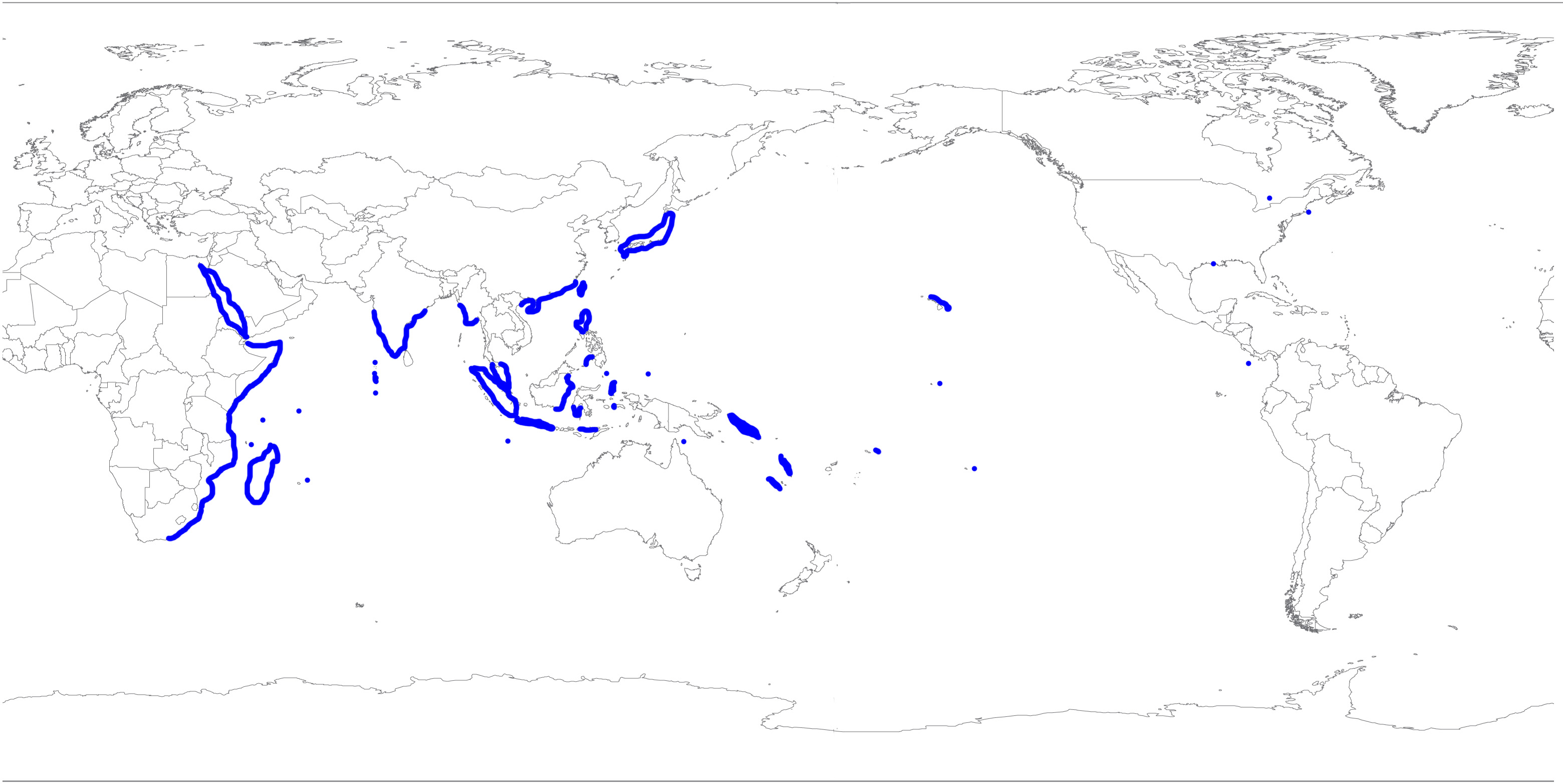 |
| Distribution of Horn-eyed ghost crab (blue) |
Coco Island,
Hawaii,
Japan,
Kenya,
Madagascar,
Malaysia,
Mauritius,
Mozambique,
Philippines,
Seychelles,
Singapore,
Somalia,
South Africa,
Tanzania,
Red Sea,
India,
Maldives,
Burma,
Sumatra,
Christmas Islands,
Taiwan,
China,
Indonesia,
New Britain,
Australia,
Solomon Island,
Vanuatu,
New Caledonia.
Biology & Behavior
Running
As it's name suggests, ghost crabs are very fast runners. In fact they are the fastest crustaceans on sandy beaches, reaching speeds of up to 2.0 m/s or 7.2 km/hr [4], that is almost as fast as the world record time for 50m freestyle swim (8.53 km/hr). The most common gait of running for ghost crabs is to use only three legs. Legs 2 and 4 on one side and leg 3 on the other is in contact with the ground at any one time, acting as a tripod for support.[4]
The crab then pushes itself in the direction it wants to travel in. It is able to travel at high speeds by leaping into the air, therefore it it is able to travel at high speeds without increasing the rate at which its moves its legs.
Diet and Feeding Behavior
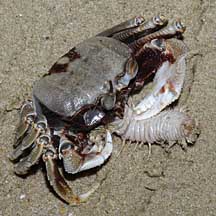 |
| Ghost crab eating firework (Photo: Ria Tan) |
Ghost crabs have several methods of feeding[3]:
1) Foraging
This is a general method of feeding where the crabs comb areas for food. Surprisingly, ghost crabs are able to detect the fine ridge left behind by the highest tidal wave. Crabs will comb the ridge looking for food, flipping obstacles such as rocks and sticks with their chelipeds. Any objects that moves are attacked and consumed if edible.
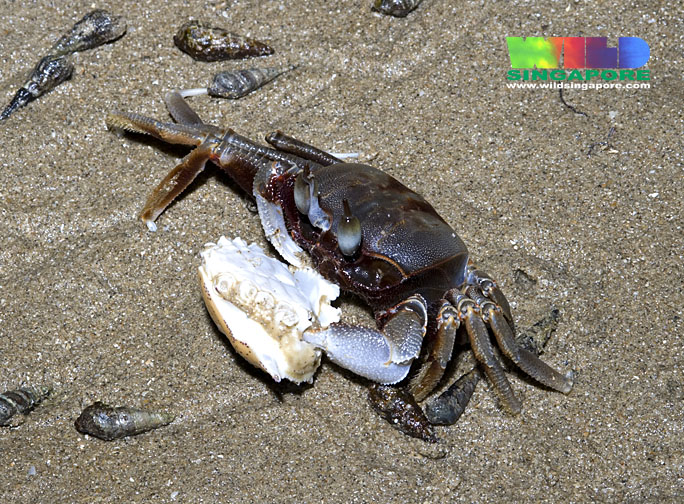 |
| Ghost crab eating a Moon crab (Photo: Ria Tan) |
Horn-eyed ghost crabs are known to consume decomposing organic material. They have been observed to feed on dead fishes, crabs and other animals.
3) Sand Pellet Feeding
These crabs have been observed to sift through sand filtering out organic material and forming sand pellets in the process. The mouthparts have developed setae and a sizable maxilliped indicating proper adaption to shifting through sand (Jones, 1972).5
4) Predatory feeding
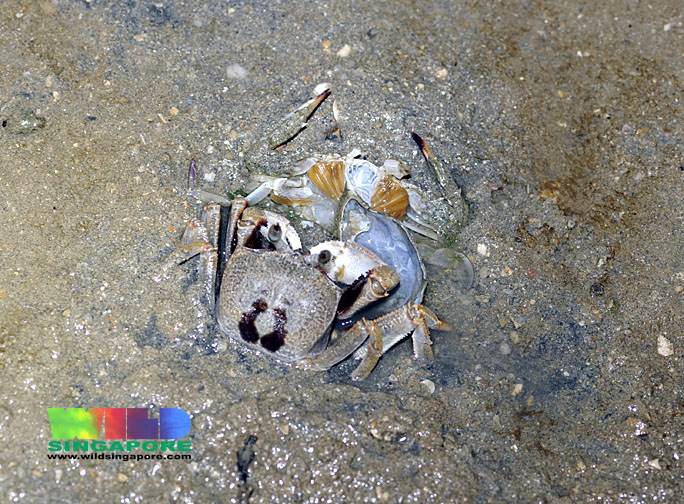 |
| Ghost crab eating a portunid crab, flower crab. (Photo: Ria Tan) |
5) Cannibalism
Larger individuals cannibalise on smaller ones.
6) Donax Feeding
Horn-eyed ghost crabs are able to precisely located buried clams (Donax faba and D. incarnate). These clams are then excavated using two walking legs on each side. The extracted clams are then crushed by the chelipeds and the flesh consumed. Most adult crabs are able to crush shells less then 12mm in anterior-posterior length. If the clam is too large, the crab will try to break the edges and attempt to pry it open by maneuvering the cheliped within the shell. If the clam densities are high, the crab might abandon tough clams for easier targets.
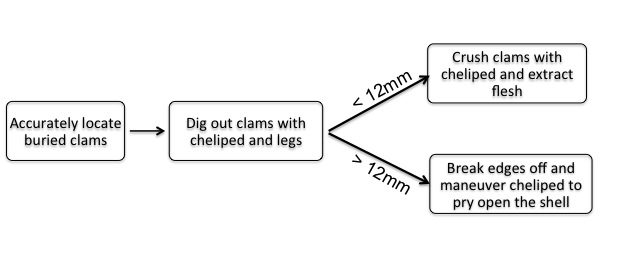 |
| Donax feeding in ghost crabs |
Burrowing
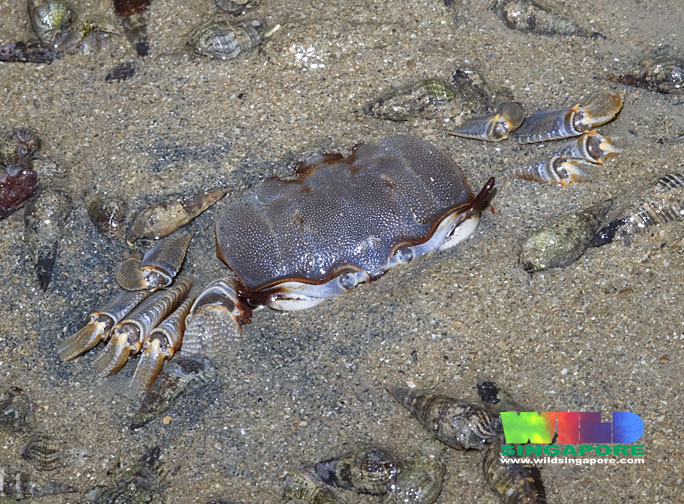 |
| Half buried crab (Photo: Ria Tan) |
The many burrows scattered along the beach during low tide is usually an indicator of ghost crabs. Burrowing behaviour has been clearlydocumented and each burrow is observed to house only one crab.
Crabs have been observed to burrow in areas where the sand is not too hard or too soft for excavation. When a crab emerges from the burrow, it carries a mass of sand with its smaller cheliped and legs. The sand is carried away from the burrow (<1m) before dropping it before returning to its burrow. Sand surrounding the entrance of burrow is compacted and flattened using its legs and chelipeds.[1] This makes the entrance of the burrow level with the surrounding terrain.
Interestingly, adult burrows have been found to be clockwise or anti-clockwise. It seems that crabs with larger right chelipeds dig clockwise burrows while crabs with larger left chelipeds dig anti-clockwise burrows.[1] This directionality of the burrows might allow the most freedom for the larger cheliped should the cab need to defend it’s burrow.[3] This is similar to the structure of stairways in medieval castles which favored the righthanded defenders.[3]
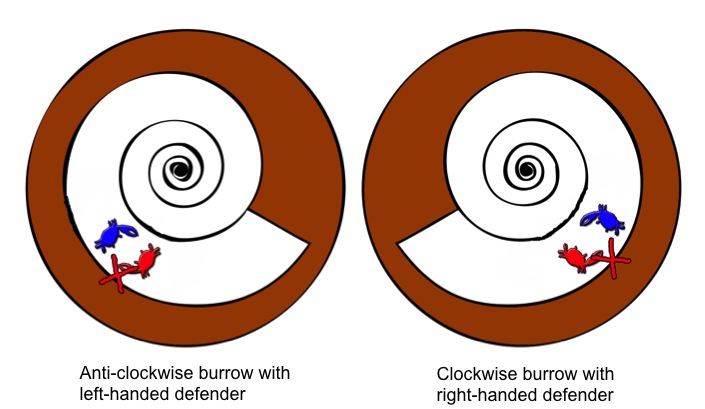 |
| Orientation of burrow allowing the defender (blue crab) freedom to use larger claw to fight against intruder (red crab) |
Burrows of juveniles (<2cm carapace width) on the other hand showed no particular fixed pattern. Burrows ranged from straight to curve and of varying depths. Depth of burrows is often depending on the period of time available for digging and its location on the beach; the higher the position of the burrow on the beach the deeper the burrow. Excavated sand can be disposed of in several ways; from organized heaps away from the burrow to radial dispersal around the entrance. In all cases, sex of the crab does not affect the type of burrow constructed.[3]
Besides having directionality, three different types of burrows have been observed too.
1) Emergence burrows
These burrows are range from 20-25cm and not deeper as difficulty of digging increases as the sand gets more compact.
2) Open burrows
Open burrows ranging from 0.3-1.3m deep are used as a platform for scavenging or digging. Construction of these burrows involves the removal of sand, which is done radially from the burrow. And this is mostly carried out in the day where predators can be seen. Should excavation be carried out at night, sand will be piled near the entrance of the burrow. These burrows are built when the area where the crab forages is submerged or if the crab leaves its burrow earlier then usual. It can also occur if crabs change their emergence burrow to that of an open burrow to forage from that area. Crabs returning with food before the next high tide may also build these burrows.
3) Covered burrows
This is often dug in haste such as in the case of rising tides. Crabs dig directly into the sand and covering the entrance as they burrow in.
Threats/Social interactions
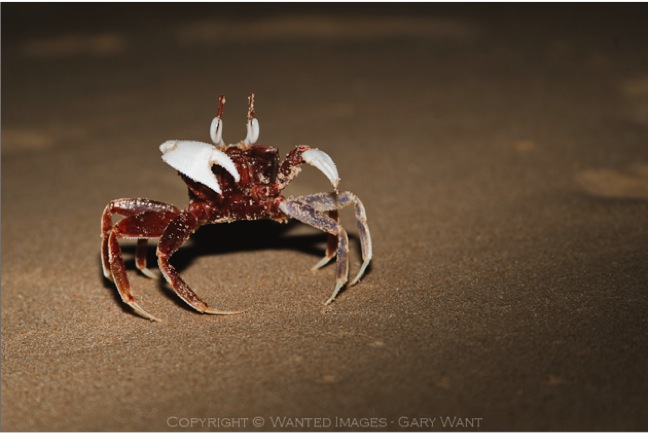 |
| Crab in defensive position (Photo: Gary Want) |
If a crab is threatened by other species, it assumes a threat posture that is displayed by raising itself on the last three pairs with the cephalothorax vertically positioned. Chelipeds are placed in front of the carapace. With this posture, the crab attempts to enhance its size visually to intimidate the threat.[5]
If faced with another crab of the same species, the response of the crab depends on the size of the other. If the opposing crab is of a smaller size, the crab will overpower and devour it. The smaller crab will attempt to escape if possible. If crabs are evenly matched in terms of size, the crabs will enter a faceoff where the threatened posture will be adopted to intimidate its opponent. Should the opponent be unfazed, crabs will start “paddling” chelipeds followed by swift strikes at the opponent using their chelipeds. However, these actions occur within a short amount of time; after striking at each other, crabs will retreat to their own burrow or run away.
Stridulation
The purpose of stridulating is to act as a warning signal to other crabs. It is to send the message to others that the burrow is occupied to fend off intruders or to possibly attract mates.[1][3] Ghost crabs stridulate by rubbing the tubercles on the inner face of the propodus of the larger cheliped against a ridge on the ischium.[3] Crabs of this species can produce 3 different types of sound.
1) The most commonly heard sound is a rapid rattling sound consisting of three to seven rasping sound which goes by Krr-Krr-Krr-Krr-KirriKrr.
2) Another sound made is a burbling bubbling noise which last for a few seconds and produced at increasing volume.
3) The third is multiple strong knocking sound which is can be heard up to 20m away.
Ecological Importance
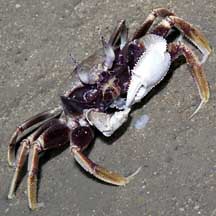 |
| (Photo: Ria Tan) |
Beaches are important places for recreation and many other activities. As such as the demands for them increase, it is vital that there is arapid assessment method that can be used to assess human impact on beaches so that proper actions can be take to managed them in a sustainable way .
As horn-eyed ghost crabs are commonly found on many sandy beaches, it has the potential to be bioindicators of human activities or impact of these beaches.[6] Research have found that there are fewer burrows on beaches with greater human activities. Increased boat activities also effected the burrow counts on beaches.[6] The presence of juvenile crabs may also indicate the health of the population, fewer juveniles present might mean the that the population is not recruiting or the rate of recruitment is low. By measuring population dynamics we can get compare this data with the level of human disturbance on the beach allowing us to assess the level of human impact. [6] Moreover, since the method for assessing beach health is quantifying burrow and human traffic, it is a much quicker, cheaper and simpler way than measuring all environmental factors.[6] Thus, in the future if you ever go to a beach and you notice that there are no ghost crab burrows, this might mean that human traffic on the beach is at levels where it is affecting the wildlife populations there.
Name
When people think of taxonomy, they often think it is boring and only for scientists to do. So why should we care about the taxonomy of the organisms? The name (nomenclature) of an organism is important as it allows for proper documentation and for people to communicate properly about the animal. The proper description of the animal also ensure that people will not confuse it with other species.
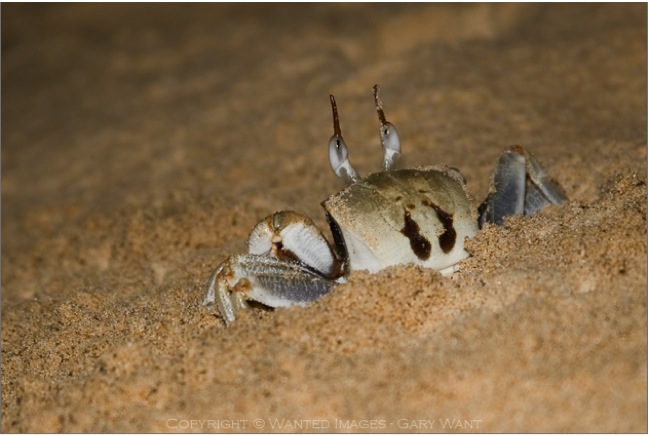 |
| Ghost crab looking into the distance (Photo: Gary Want) |
| Common Name |
Used in |
Language |
|
| Agoyokoy |
Philippines |
Cebuano |
|
| Ghost crab |
Hawaii |
English |
|
| Horn-eyed ghost crab |
Philippines |
English |
|
| Horned ghost crab |
USA |
English |
|
| 'ohiki |
Hawaii |
Hawaiian |
|
| `o¯hiki |
Hawaii |
Hawaiian |
|
| Bayokoy |
Hiligaynon |
Philippines |
|
| Tsunome-gani |
Japan |
Japanese |
|
| Taxonavigation Kingdom: Animalia (Linnaeus, 1758) Phylum: Arthropoda (Latreille, 1829) Subphylum: Crustacea (Brünnich, 1772) Class: Malacostraca (Latreille, 1802) Order: Decapoda (Latreille, 1802) Infraorder: Branchyura (Linnaeus, 1758) Family: Ocypodidae(Rafinesque, 1815) Subfamily: Ocypodinae (Rafinesque, 1815) Genus: Ocypode(Weber, 1795) Species: O. ceratophthalmus |
Synonyms ▪ Cancer ceratophthalmus (Pallas, 1772) ▪ Cancer caninus (Herbst, 1782) ▪ Ocypode urvillei (Guérin, 1829) ▪ Ocypoda macleayana (Hess, 1865) ▪ Ocypode brevicornis var. longicornuta (Dana, 1852) |
Taxonomic History and Etymology
The common name "ghost crab" is used to describe it nocturnality and pale colored carapace. The genus of this crab describes the speed of these crab, ocy- means swift in Greek and podos means foot, thus the crabs in this genus are swift-footed. Ceratophthalmus is used to describe the horns on top of the crab’s eyes as cer- means horned in Greek.
 |
| Original description by Pallas in 1772 |
This species of was originally described as Cancer ceratophthalmus by Pallas in 1772, Fabricius however shifted the species to Ocypode in 1798 and Latreille designated it as the type species in 1810.[7] However, it is interesting to note that neither type specimen nor type locality has been mentioned in any papers.
Diagnosis
 |
| Distinctive features of Horn-eyed ghost crabs (circled in yellow) (Photo: Ria Tan) |
This section will help you differentiate this crab from other crabs. Horn-eyed ghost crabs can be easily distinguished from other crabs by the horn-stalks on the eyes.[8][9] Females have smaller shorter hornswhile the juveniles may not have any.[8] The carapace is box-shaped with deep indentations to allow eyes to be kept. A distinct dark cervical groove (H-shape marking on the back) can also be found on the top of the carapace.[9]
Description
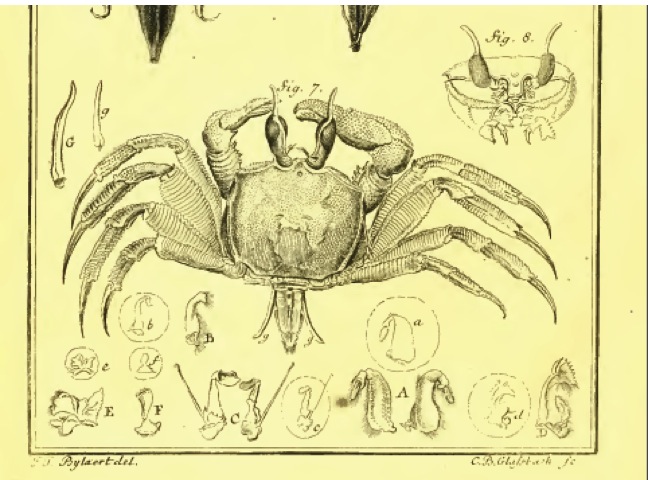 |
| Original drawing of Ocypode ceratophthalmus by Pallas in 1772 |
Description of Ocypode ceratophthalmus by Türkay (1995). [10]
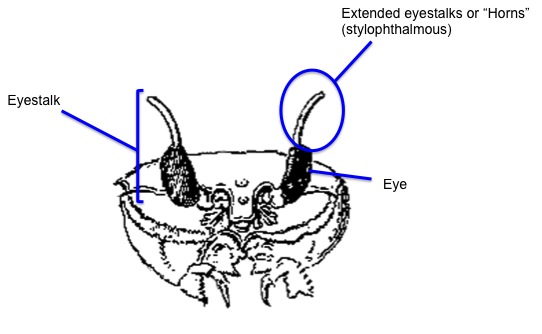 |
| Anterior view of crab |
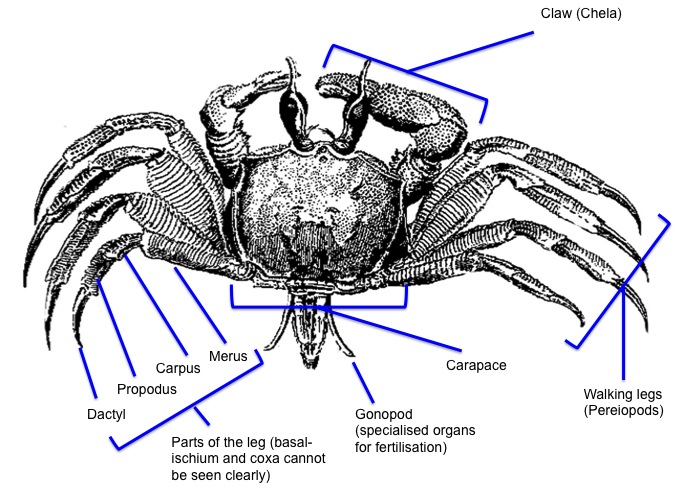
| Size |
Middle sized to large animals. |
| Eyestalks |
Eyestalks extended beyond cornea (stylophthalmous). Exorbital corner laterally directed in large specimens. |
| Chela |
Stridulating ridge on inner surface of palm of major chela composed of about 13-16 distant striae in upper half and 20-30 close set ones in lower half. Small chela with both fingers pointed. |
| Pereiopods |
Upper half of propodi of second and third pereiopods with a velvet. |
| Pleopod |
Male: First pleopod slender, its distal part clearly bent laterally, palp with long and slender tip, its distance to pleopod tip slightly more than palp length. |
| Female: Opercle of female genital duct with depressed operculum, vulva-opening oblique with respect to median line of sternum, lateral rims not elevated. |
References:
1) Barrass, R., 1963. The burrows of Ocypode ceratophthalmus (Pallas) (Crustacea, Ocypodidae) on a tidal wave beach at Ihaca Island, Moçambique. Journal of Animal Ecology. 32(1): 73–85.
2) Serene, R., 1977. Crustaces Hippides et Brachyoures des iles Sechelles. Revue de Zoologie Africaine. 91(1): 45–68.
3) Hughes, D. A., 1966. Behavioural and ecological investigations of the crab Ocypode ceratophthalmus (Crustacea: Ocypodidae). Journal of Zoology (London). 150: 129–143.
4) Burrows, M. & G. Hoyle, 1973. The mechanism of rapid running in the ghost crab, Ocypode ceratophthalma. Journal of Experimental Biology. 58: 327–349.
5) Jones, D. A., 1972. Aspects of ecology and behavior of Ocypode ceratophthalmus (Pallas) and O. Kuhlii de Haan. (Crustacea: Ocypodidae). Journal of Experimental Marine Biology and Ecology. 8: 31–34.
6) Yong, A. Y. P. & Lim, S. S. L., 2009. The potential of Ocypode ceratophthalmus (Pallas, 1772) as a bioindicator of human disturbance on Singapore beaches. Crustaceana. 82(12): 1579–1597.
7) Ng, P. K. L., Guinot, D. & Davie, P. J. F., 2008. Systema brachyurorum: Part I. An annotated checklist of extant brachyuran crabs of the world. The Raffles Bulletin of Zoology. 17:1–286.8) Tan R., 2008. Horn-eyed ghost crab. Wild Singapore. Assessed on 2 Nov 2011, from: http://www.wildsingapore.com/wildfacts/crustacea/crab/ocypodoidea/ceratophthalmus.htm
9) Queensland Museum, 2011. Horn-eyed Ghost Crab. Queensland Government. Assessed on 2 Nov 2011, from: http://www.qm.qld.gov.au/Find+out+about/Animals+of+Queensland/Crustaceans/Common+marine+crustaceans/Crabs/Horn-eyed+Ghost+Crab10) Marine Species Identification Portal. Sand crab (Ocypode ceratophthalmus). Assessed on 2 Nov 2011, from: http://species-identification.org/species.php?species_group=crabs_of_japan&id=1756
External Links
Information related to Horn-eyed Ghost crabs:
Wikipedia
Encyclopedia of life
Sea Life Base
World register of Marine Species
Queensland museum
Wild Singapore
NCBI taxonomy browser
iSpecies
Encyclopædia Britannica Online
Marine Species Identification portal
Atol decapoda
Barcode of Life Data Systems